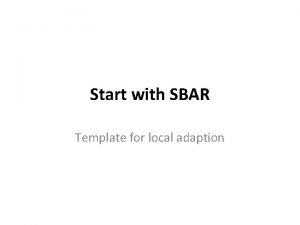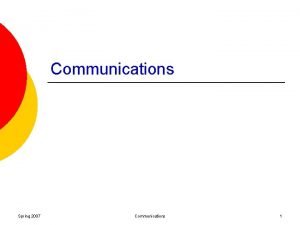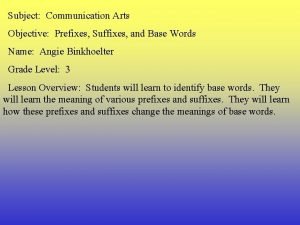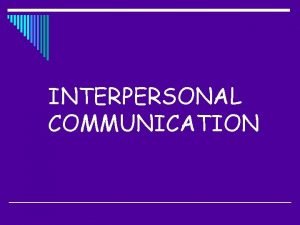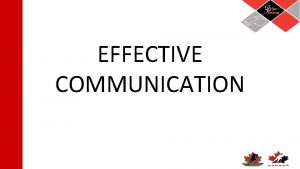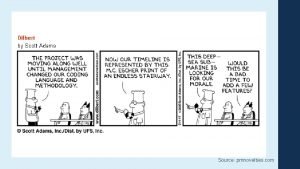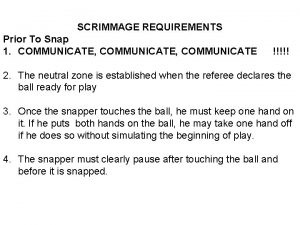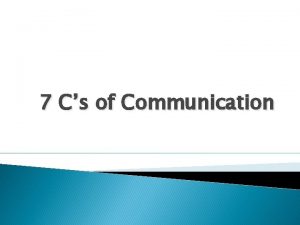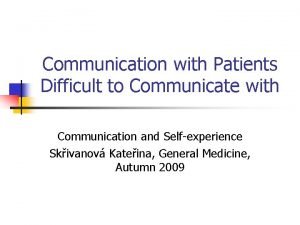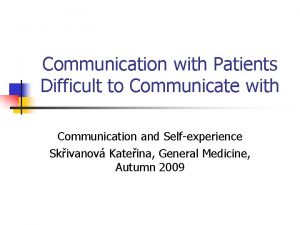Effective Communication Effective Communication Model How We Communicate














- Slides: 14

Effective Communication

Effective Communication Model

How We Communicate

Communication Styles PASSIVE AGGRESSIVE ASSERTIVE

Passive Communicator • Is afraid to speak up • Avoids direct eye contact • Shows little or no expression • Isolates self from groups • Agrees with others despite feelings • Values self less than others • Does not reach goals • You’re okay; I’m not.

Assertive Communicator • Speaks openly • Makes good eye contact • Shows expression to match the message • Participates in groups • Speaks to the point • Values self equal to others • Reaches goals without alienating others • I’m okay; you’re okay.

Aggressive Communicator • Interrupts and ‘talks over’ others • Glares and stares at others • Intimidates others with expressions • Dominates and controls groups • Only considers own feelings • Values self more than others • Reaches goals regardless of impact on others • I’m okay; you’re not.

5 Things Great Communicators Do 1. They speak with clarity and influence √ 2. They advocate a common vision √ 3. They listen √ 4. They effectively use body language √ 5. They are culturally and politically aware √

Intercultural Communication A different language is not just a dictionary of words, sounds, and syntax. It is a different way of interpreting reality, refined by the generations that developed the language. Federico Fellini

Intercultural Communication Patterns Collectivist Cultures Individualistic Cultures • Less focus on verbal interactions • More focus on nonverbal interactions • Less focus on nonverbal interactions • Often communicate using indirect style • Mainly use direct communication style • Context of communication is more important • What is said is more important • Socially interdependent • Independent • Duties and obligations define behaviour • Attitudes and personal needs define behaviour

Low & High Context Cultures Low Context High Context

Tips for Effective Intercultural Communication Speak clearly & slowly Show respect for others Avoid making assumptions Be supportive Avoid jargon or metaphors Allow time for a response Check meanings Ask questions

Effective Communication Worksheet & Games Understanding Idioms We often use idioms when we speak. The use of idioms in a language adds colour to it and makes it more interesting for the listeners. Understanding idioms is an integral part of language fluency and an essential competence for integration into host communities. Click on the link below to play the idiom game and develop your essential language skills. www. theidiomgame. eu

Thanks! All Photographs courtesy of Pixabay. com This project has been funded with support from the European Commission. This document reflects the views only of the author and the Commission cannot be held responsible for any use which might be made of the information contained herein. Project Number: 2017 -1 -FR 01 -KA 204 -037126
 Effective communication types
Effective communication types Purpose to inform
Purpose to inform Sbar template
Sbar template Jesip communicate
Jesip communicate How do people communicate
How do people communicate Effectively communicate meaning
Effectively communicate meaning Channel richness
Channel richness Communication skills definition
Communication skills definition How do people communicate
How do people communicate Avulsion fractire
Avulsion fractire Training managers to communicate effectively
Training managers to communicate effectively Communicate suffix word
Communicate suffix word Communicating value
Communicating value Interpersonal communication is inescapable
Interpersonal communication is inescapable Objects communicate with each other through
Objects communicate with each other through


